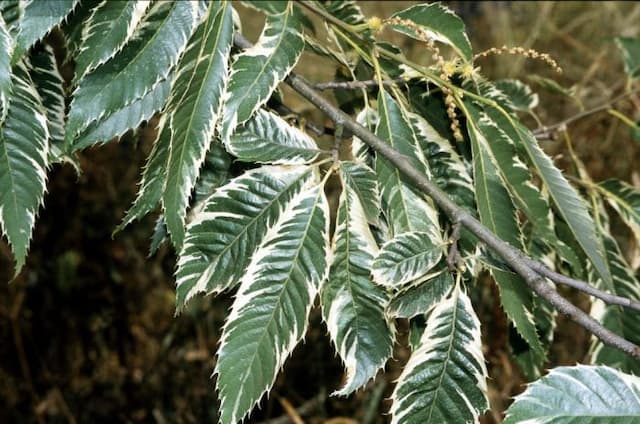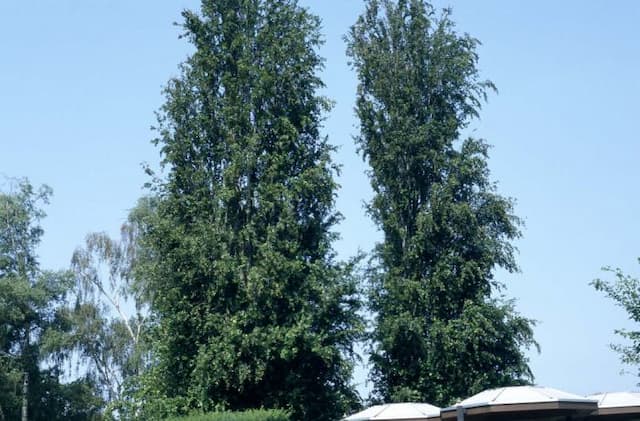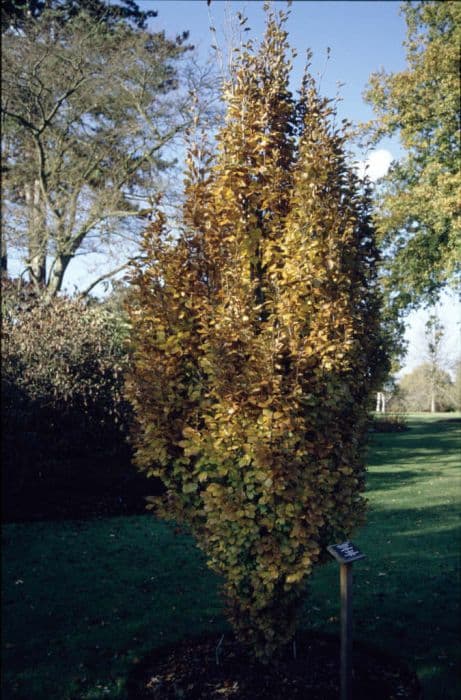Northern Pin Oak Quercus ellipsoidalis

ABOUT
The plant in question, commonly known as the Northern Pin Oak or Hill's Oak, is a deciduous tree notable for its distinctively shaped leaves and rich fall coloration. The leaves are glossy and green, usually with 5-7 lobes that are deeply cut, giving them a somewhat pinched appearance. Each lobe ends in a pointed tip, while the sinuses between lobes are rounded. In the fall, the foliage undergoes a striking transformation, turning into shades of bright red or bronze, adding a splash of color to the landscape. The bark of the Northern Pin Oak is another distinctive attribute; it is dark and deeply ridged, providing a textured look and feel. The bark's pattern includes ridges and furrows that run vertically along the trunk and branches, giving the tree a rugged appearance. Flowering in late spring, the Northern Pin Oak produces inconspicuous flowers, with males in drooping catkins and females in short spikes. As the seasons progress, these flowers give way to acorns, which are the fruit of the tree. The acorns are small, enclosed for about one-third of their length in a shallow, scaly cup. Overall, the Northern Pin Oak has a strong, impressive presence, thanks to its robust branching structure. Its branches grow somewhat horizontally but with an upward tilt, contributing to the tree's overall rounded canopy. The combination of its seasonal leaf color, distinctive bark, and strong branch patterns makes it an attractive and recognizable species in its native habitat.
About this plant
 Names
NamesSynonyms
Northern Pin Oak, Hill's Oak, Jack Oak.
Common names
Quercus ellipsoidalis E.J.Hill, Quercus conferta Kit.
 Toxicity
ToxicityTo humans
The Quercus ellipsoidalis, commonly known as the northern pin oak, is not generally considered highly toxic to humans. However, like other oak species, it produces acorns and leaves which contain tannins. Ingestion of large quantities of acorns or foliage has the potential to cause stomach upset, kidney damage, or tannin poisoning. Tannins can cause gastrointestinal distress, such as nausea, vomiting, and diarrhea. In severe cases, tannin poisoning can lead to more serious symptoms, including kidney damage if consumed in excessive amounts over a long period of time.
To pets
The Quercus ellipsoidalis, commonly known as the northern pin oak, can be toxic to pets if they consume parts of the plant, particularly the acorns or leaves. These plant parts contain tannins, which can cause gastrointestinal upset in animals such as dogs and cats. Symptoms of oak poisoning in pets may include vomiting, diarrhea, abdominal pain, and constipation. In severe cases, ingestion of large amounts of acorns or leaves can lead to kidney damage, dehydration, and lethargy. Owners should prevent their pets from ingesting acorns or leaves from the northern pin oak to avoid these toxic effects.
 Characteristics
CharacteristicsLife cycle
Perennials
Foliage type
Deciduous
Color of leaves
Green
Flower color
Varies
Height
40-60 feet (12-18 meters)
Spread
40-60 feet (12-18 meters)
Plant type
Tree
Hardiness zones
4
Native area
North America
Benefits
 General Benefits
General Benefits- Wildlife Habitat: Quercus ellipsoidalis, commonly known as the Northern Pin Oak, provides shelter and nesting sites for various species of birds and mammals.
- Food Source: The acorns produced by the Northern Pin Oak are a valuable food source for wildlife such as squirrels, deer, and birds.
- Erosion Control: The extensive root system of the Northern Pin Oak helps stabilize soil and prevent erosion.
- Shade and Cooling: As a deciduous tree, it offers shade during the summer months, thus aiding in cooling urban areas and reducing energy costs for cooling buildings.
- Beautification: With its distinct, deeply lobed leaves and fall coloration, the Northern Pin Oak adds aesthetic value to landscapes and urban environments.
- Carbon Sequestration: Like other trees, the Northern Pin Oak absorbs carbon dioxide from the atmosphere, helping to mitigate climate change by storing carbon in its biomass.
 Medical Properties
Medical PropertiesThis plant is not used for medical purposes.
 Air-purifying Qualities
Air-purifying QualitiesThis plant is not specifically known for air purifying qualities.
 Other Uses
Other Uses- The acorns of the Northern Pin Oak can be ground into flour after leaching out the tannins, providing a sustenance food source for baking or cooking.
- Its wood, being hard and heavy, is occasionally used for constructing fence posts or in railway ties where durability is crucial.
- Northern Pin Oak bark can be utilized for tanning leather due to the presence of tannic acid in the bark.
- The tree's dense wood is suitable for crafting fine furniture and cabinetry, often appreciated for its grain and finish.
- Its leaves can serve as a natural mulch that contributes nutrients back to the soil as they decompose.
- The acorns of Northern Pin Oak, like those of other oaks, can be used in various crafts and decorations, especially in autumn displays.
- Due to its ornamental appearance, Northern Pin Oak can be planted in parks and large gardens for aesthetic purposes, particularly for its distinctive fall colors.
- The strong branches of the Northern Pin Oak are sometimes used in landscaping to support climbing plants or to hang bird feeders.
- Its dense canopy can provide habitat structures within arboretums and conservation areas for local wildlife and bird species.
- The sawdust and wood chips of the Northern Pin Oak can be used for smoking meats, imparting a unique flavor to barbecues and grills.
Interesting Facts
 Feng Shui
Feng ShuiThe Northern Pin Oak is not used in Feng Shui practice.
 Zodiac Sign Compitability
Zodiac Sign CompitabilityThe Northern Pin Oak is not used in astrology practice.
 Plant Symbolism
Plant Symbolism- Strength - As a species of oak, Quercus ellipsoidalis, commonly known as the Northern Pin Oak, symbolizes strength due to the hardwood nature and sturdy structure of oak trees.
- Endurance - Northern Pin Oak is associated with endurance because it can withstand harsh conditions, which is reflective of its capacity to survive in less fertile soil which would typically be inhospitable for other oaks.
- Wisdom - Oak trees in general are often seen as ancient beings that represent wisdom and knowledge, and the Northern Pin Oak is no exception to this symbolic meaning.
- Nobility - The oak is considered a noble tree across various cultures, and so the Northern Pin Oak is similarly seen as a representation of nobility and honor.
- Stability - The deep root system of the Northern Pin Oak conveys a sense of stability and groundedness, qualities that are idealized in human character and society.
 Water
WaterThe Northern Pin Oak requires deep watering to establish its root system, especially during the first few years after planting. Once established, it is drought-tolerant and should be watered deeply but infrequently, about once every two to three weeks, with approximately 1-1.5 gallons per inch of trunk diameter at each watering session. During hot and dry spells, watering frequency should increase to once a week. Ensure that the soil around the tree is moist but not waterlogged, to encourage healthy growth and avoid root rot.
 Light
LightNorthern Pin Oak thrives in full sun, meaning it does best with at least six hours of direct, unfiltered sunlight each day. The best spot for the tree is in an open area, away from buildings or other larger trees that might cast shade on it, to ensure it receives ample sunlight throughout the day.
 Temperature
TemperatureNorthern Pin Oak is able to withstand a wide range of temperatures, making it a hardy choice for many climates. It can survive minimum temperatures as low as -30°F and is comfortable in the heat up to about 100°F, though it naturally prefers the cooler climate of its native regions. The ideal temperature range for the Northern Pin Oak is between 60°F and 80°F.
 Pruning
PruningPruning the Northern Pin Oak is essential to maintain its shape, remove any dead or diseased wood, and improve air circulation. The best time to prune is late winter to early spring, before new growth begins. Prune no more than one-third of the crown at a time, and make clean cuts to prevent damage to the tree. Removing lower branches may also be necessary as the tree matures, to allow clearance underneath.
 Cleaning
CleaningNot needed
 Soil
SoilThe Northern Pin Oak thrives best in a well-draining soil mix composed of loamy or sandy loam soils. It prefers a soil pH range of 5.0 to 7.0. Amend garden soil with compost to improve texture and nutrients if necessary.
 Repotting
RepottingThe Northern Pin Oak, being a large tree, is not typically repotted. In landscape situations, it does not require repotting but may need transplanting to a larger area as it grows.
 Humidity & Misting
Humidity & MistingThe Northern Pin Oak is tolerant of a wide range of humidity levels and does not require specific humidity conditions when grown outdoors in its natural habitat.
 Suitable locations
Suitable locationsIndoor
It's impractical to grow Northern Pin Oak indoors due to its size.
Outdoor
Plant in full sun, ensure adequate space for growth.
Hardiness zone
4-7 USDA
 Life cycle
Life cycleThe Northern Pin Oak (Quercus ellipsoidalis) begins its life cycle when a fertilized acorn germinates, often requiring full sunlight and a well-drained soil to thrive. The seedling emerges and grows into a young sapling, establishing a root system and beginning to develop a sturdy stem. As a sapling, the Northern Pin Oak may continue to grow for several years, developing into a mature tree with a thick trunk, strong branches, and dense canopy of deeply lobed leaves. Each year, the tree undergoes a growth period during the spring and summer, followed by a dormant period in the fall and winter when leaves turn colors and drop. Reproductive maturity is reached after 20-40 years, with the tree producing flowers and then acorns; the flowers are wind-pollinated, leading to the development of new acorns that serve as seeds for the next generation. The Northern Pin Oak can live for over a century, continuing the cycle as old trees die and new oaks germinate from fallen acorns.
 Propogation
PropogationPropogation time
Spring-Early Summer
Propogation: The Northern Pin Oak, or Quercus ellipsoidalis, is commonly propagated by seed, specifically acorns. The optimal time for propagating this species by seed is in the autumn, immediately following acorn drop. Acorns should be collected when they fall naturally from the tree, indicating ripeness. Fresh acorns have a higher germination rate than those that have been stored; however, if necessary, acorns can be stored in a cool, dry place until planting. To propagate by seed, the acorns are sown directly into the soil at a depth approximately three times the diameter of the acorn, which is typically about 1 to 1.5 inches (2.5 to 3.8 centimeters). This approach mimics the natural process where acorns germinate after falling to the forest floor. Soil should be well-drained and kept moist but not waterlogged to encourage germination and root development. Seedlings typically emerge in the spring following overwintering in the soil.









